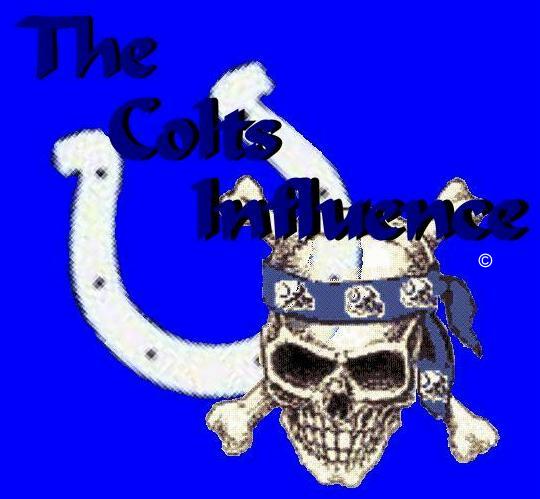|
The Colts Influence
Constructed, destructed and reconstructed
Colts
FORUM
Colts
BLOG
The Colts Influence www.mycolts.net/coltsinfluence http://myspace.com/coltsinfluence
|
FOOTBALL 101
GETTING
STARTED THE
FIELD RULES
TIMING
THE PLAYERS
KICKING One 11-man team has possession of the football. It is called the offense and it tries to advance the ball down the field-by running with the ball or throwing it - and score points by crossing the goal line and getting into an area called the end zone.
The other team (also with 11 players)
is called the defense. It tries to stop the
offensive team and make it give up possession of the ball.
The field measures 100 yards (360
feet) long and 53 yards (160
feet) wide. Little white
markings on the field called yard markers help the players, officials,
and the fans keep track of the ball.
Obviously the team with the most points at the end of
the game wins. So the offense tries to get as many touchdowns
as they can and the defense tries to stop them.
There are rules (OFFICIAL
NFL RULES) and procedures to
follow like in any sport. Breaking a rule is called a penalty.
The team that gets called for a penalty usually looses yardage. In the game the Officials (nicknamed "Zebras" because of their striped shirts) can call a penalty by "throwing a flag", a yellow flag is carried in the back pocket of each man. When the flag is thrown the play is normally run and the penalty assessed after the play. Various penalties, normally 5, 10 or 15yards are enforced depending on the infringement. If the team who has been offended has gained more yards than would be enforced on the penalty then they can "decline" the penalty and take the yardage gained.
Games are divided into four 15-minute quarters, separated by a 12-minute break at halftime. There are also 2-minute breaks at the end of the first and third quarters as teams change ends of the field after every 15 minutes of play.
At the end of the first and third quarters, the team
with the ball retains possession heading into the following quarter.
Each offensive team has 40 seconds from the end of a
given play until they must snap
the ball for the start of the next play, The clock stops at the end of incomplete passing plays, when a player goes out of bounds, or when a penalty is called. The clock starts again when the ball is re-spotted by an official.
If a game is tied at the end of regulation, a
15-minute overtime period will be played.
Each team has 3 separate units:
Teams also must kick the ball. They use another set of players call special teams. To start the game there is a kickoff. When the offense cannot move the ball they punt. After a score the scoring team kicks an extra point. The offensive team may try a field goal to score points. These are specific formations and need special players called kickers and punters.
A game starts with the kickoff. The ball is placed on
a kicking tee at the defense's 30-yard line, and a special kicker (a
"placekicker") kicks the ball to the offense. A kick
return man from the offense will try to catch the ball and advance it
by running. Where he is stopped is the point from which the offense
will begin its drive, or series of offensive plays. When a kickoff is
caught in the offense's own end zone, the kick returner can either
run the ball out of the end zone,
All progress in a football game is measured in yards. The offensive team tries to get as much "yardage" as it can to try and move closer to the opponent's end zone. Each time the offense gets the ball, it has four downs, or chances, in which to gain 10 yards. If the offensive team successfully moves the ball 10 or more yards, it earns a first down, and another set of four downs. If the offense fails to gain 10 yards, it loses possession of the ball. The defense tries to prevent the offense not only from scoring, but also from gaining the 10 yards needed for a first down. If the offense reaches fourth down, it usually punts the ball (kicks it away). This forces the other team to begin its drive further down the field.
A play begins with the snap.
At the line
of scrimmage (the position on the field where the play begins),
the quarterback
loudly calls out a play in code and the player in front of him, the
center, passes, or snaps the ball under his legs to the quarterback.
There are two main ways for the offense to advance the ball.
The other alternative to running the ball is to throw it.
The defense prevents the offense from advancing the ball by bringing the ball carrier to the ground. A player is tackled when one or both of his knees touch the ground. The play is then over. A play also ends when a player runs out of bounds.
The object of the game is to score the most points.
A touchdown is the biggest single score in a football game. It is worth six points, and it allows the scoring team an opportunity to attempt to get an extra point. To score a touchdown, the ball must be carried across the goal line into the end zone, caught in the end zone, or a fumble recovered in the end zone, or an untouched kickoff recovered in the end zone by the kicking team.
Immediately following a touchdown, the ball is placed at the opponent's two-yard line, where the offense has two options. Usually the offense will kick an extra point, also called the point after touchdown, conversion, or PAT. If the offense successfully kicks the ball through the goal posts, it earns one point. The offense can also score two points by running or throwing the ball into the end zone in the same manner as you would score a touchdown. Since going for two points is more difficult than kicking an extra point, the offense generally chooses to kick the extra point.
If the offense cannot score a touchdown, it may try to kick a field goal. Field goals are worth three points and often are the deciding plays in the last seconds of close games. They can be attempted from anywhere on the field on any down, but generally are kicked from inside the defense's 45-yard line on fourth down. For a field goal to be "good", the placekicker (or field goal kicker) must kick the ball through the goal-post uprights and over the crossbar. The defense tries to block the kick and stop the ball from reaching the goal post.
The safety is worth two points. A safety occurs when the offensive ball carrier is tackled behind his own goal line.
While trying to advance the football to the end zone, the offense may accidentally turn the ball over to the defense in one of two ways:
When the ball carrier or passer drops the ball, that's
a fumble. Any player on the field can recover the ball by diving on
it or he can run with it.
An aggressive defense can regain possession of the ball by catching (intercepting) passes meant for players on the other team. Both fumble recoveries and interceptions can be run back into the end zone for touchdowns.
THE TWO SIDES OF THE BALL THE OFFENSE Whichever team has possession of the ball is the offense. While only the quarterback, the wide receivers and tight ends, and the running backs can legally handle the ball, it is the quarterback who is the leader of the team and the playmaker. In fact, he's a man of many talents - he not only throws the ball, he outlines each play to his team.
The offense uses many different
formations to set their players to start a play. The quarterback
calls plays
and leads the team. The can handoff
or pass
the ball to a running
back or full
back. He can pass to a wide
receiver or tight
end. The linemen,
tackles,
guards
and a center,
block
for the quarterback and running backs. The offensive formation many times can tell you if they are going to pass or run the football. The formation can also tell you what side of the field the play might be run. Offenses use extra wide receivers when they need to pass the ball, or extra blockers and running backs when they need to run the ball. Teams use different strategies to try and score. Some teams like to run the ball more than pass. Some teams prefer to pass. This all depends on the type of players a team has and the style of play the coach likes to use.
- The quarterback ("QB") passes or hands off the ball. - The center snaps the ball to the QB and blocks the defense. - 2 guards and 2 tackles keep the defense at bay. - 2/4 wide receivers catch the ball thrown by the QB. - 1 or 2 running backs take the ball and run with it. - 1 or 2 tight ends block the defense and can also catch passes.
Football calls for many different strategies in a game. The offense decides on a way to play and the defense does same. What plays are chosen and against what defensive formations are all part of the offensive and coaching strategy. OFFENSIVE STRATEGIES: 1. Running game. This way a team can control the pace of the game. They can control the clock. All coaches say this is an example of what some coaches call ball control offense. 2. Passing game. Teams with good quarterbacks and receivers like to pass. They move the ball down the field by throwing long or short passes. 3. Two Minute Offense: This is when the game is in the last two minutes of either half. The offense wants to move the ball quickly down the field. Usually there is no huddle and the plays are called at the line of scrimmage. Most plays are run to the side line so the players can get out of bounds to stop the clock. If they do not get out of bounds they have to use a timeout. This stops the clock and they can get organized for the next play. The two minute offense is used also when a team gets too far behind on the score. 4. Play calling. Calling the right play at the right time can make all the difference. If the defense is expecting a run and the offense passes, a big play may result. Many teams rely on their quarterback to make the right call. A quarterback may call an audible if he sees that the defense is at a disadvantage. ________________________________________ COACHING STRATEGY Teams have scouted their opponents and look for tendencies in the way they play defense and what they do in certain situations. For example if a team always blitzes on third and long, then the offensive coaches would call a screen pass or draw. Each offensive segment coach scouts their opponent to look for ways of running a specific play. The line coach watches for the way the defensive line rushes. He then plans out the blocking scheme. The backs watches the linebackers and secondary to see how they move and where they defend. He checks if they play man or zone defense. The receivers coach watches the backs and how they cover the receivers. All the coaches then meet as a staff and report their findings to the offensive coordinator. Then they come up with the game plan for the opponent.
The job of the defense is to stop the offense. The 11 men on the defensive team all work together to keep the offense from advancing toward the defense's end zone.
The defense uses different players
to help stop the offense. The defensive formation usually matches up with the offense. But the defense can try to do different strategies to stop the offense. The defense can move players around to cause the offense problems. Defenses add extra lineman or backs if they think the offense is going to run or pass.
- Linebackers defend against the pass, and push forward to stop the run or tackle the QB. - The defensive line (ends and tackles) battles head-to-head against the offensive line. - Cornerbacks and safeties defend against the pass from the QB to the wide receiver and help to stop the run.
Football calls for many different defensive strategies in a game. The offense decides on a play and the defense tries to counter with a way to stop the play. It is like a chess match, each team trying to out wit the other. Watching how teams try to stop a play is what coaching defense is all about. What plays are chosen and against what offensive formations are all part of the defensive and coaching strategy. DEFENSIVE STRATEGIES: 1. Base Defense. This is when the defense sets in their basic or normal set. The defensive coordinator calls different plays from this set. He can call for linemen to rush differently, linebackers where to go and what pass defense to run. 2. Run prevent. This is a way the defense uses extra linemen to stop the run. The defense expects running plays and commits players to the run. A team faces an opponent that runs the ball alot will use this style. 3. Pass prevent. Defenses expect a team to pass. Many times near the end of the game if the offensive team needs to score quickly they will pass on every down. Defenses like to use this prevent style which includes extra defensive backs. 4. Zone Pass Defense. This is a pass defense where the defensive backs go to a zone or area on the field. They cover the player that comes into the zone. 5. Zone blitz. This is a new style of defense. Defenses use a zone blitz to trick the offense on how they will play the pass and who is going to blitz. 6. Play calling. Setting up the offense in a certain formation does not mean they will pass or run. Teams have many different plays for each formation. The offensive coaches try to make the defensive coaches guess what play is going to be run. COACHING STRATEGY Teams have scouted their opponents and look for tendencies in their play calling and what they do in certain situations. For example if a team always passes on second and ten, then the defensive coaches would call a pass defense. Each defensive segment coach scouts their opponent to look for ways of beating them in a specific defense. The line coach watch's for the way the offensive line blocks. The linebacker watches the quarterback and running backs how they move and where they run. The secondary coach watches the receivers and the patterns they run. All the coaches then meet as a staff and report their findings to the defensive coordinator. Then they come up with the game plan for the opponent.
For such a long and rough sport like football, substitutions are a mandatory part of this team sport since player fatigue and injury may incur as the game progresses. Therefore, substitutions can occur at any point during the game as long as no play is occurring (i.e. the ball is "dead") and that there are only 11 players from one team on the field at a time when the ball is snapped. The offense is not allowed to rush and start a play when substitutions are still occurring on the defense. If that occurs, than the play is restarted with no penalties inflicted on any side. This rule does not apply after the two-minute warning in the second and fourth quarters because time becomes a factor at these points of each halves.
______________________________________________
There are other factors in the game of football. Whether to go for it on fourth and one or kick, which play to run in certain situations and how to change to the flow of the game are all part of coaching strategy. Many coaches are conservative and do not like to take many chances during the game. Many feel that field position is very important. If you can keep the opponent on their side of the field and not move the ball much, coaches feel that the offense will move the ball. Starting with the ball your own twenty yard line (meaning you have 80 yards to go) make sit hard to score consistently. On the other hand, when you get the ball on the 50 yard line, you can score without having to gain many yards. This is known as a short field. These games with field position a big struggle can become boring on the offensive side. Teams do not want to make a mistake and run the ball more. They hope the defense will stop the other team and get the ball back with good field position. This is where special teams comes into play.
This website is an unofficial source of news and information continually updated from thousands of sources around the net. A fan based site dedicated to the Indianapolis Colts and its fans and is not associated with the Indianapolis Colts, the National Football League, any school, team or league or any other media site. This website is the composition of many hours of research. Information contained within this site has come from numerous sources such as websites, newspapers, books, and magazines. Please take the time to visit the Source page to get a semi-complete listing of these sources, articles, sites and fans.
Pictures and logos, team names are property of
the National Football League and/or The Indianpolis Colts.
Please direct website comments
|
|||




